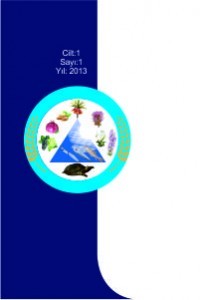Osmaniye İlinde Üretilen Beyaz Turpların Su ve Su+Etil Alkol Ekstraktlarının Kalite Özelliklerinin Belirlenmesi
ÖZET
Araştırmada Osmaniye ilinde üretilen beyaz turpların (beyaz, yeşil renkli cilt ve kırmızı etli) (Raphanus sativus L.), su ve su +etil alkol ekstraktlarının kalite özellikleri incelenmiştir. Elde edilen ekstraktlarda renk (L*, a*, b*, hue ve croma), toplam fenolik madde, toplam antioksidan aktivite ve toplam monomerik antosiyanin analizleri yapılmıştır. Beyaz turp, su ekstraktının L*, a*, b*, hue ve croma ortalama değerleri sırasıyla 23.26, 2.45, 3.30, 0.93 ve 4.14 olarak belirlenmiştir. Toplam fenolik madde, toplam antioksidan aktivite ve toplam monomerik antosiyanin miktarı 136.53 mgGAE/g, %16.01 ve 2.53 siyanidin-3-glikozit eşdeğerleri (mg/g) olarak tespit edilmiştir. Beyaz turp su+etil alkol ekstraktının ise ortalama L*, a*, b*, hue ve croma değerleri sırasıyla 24.93, 7.96, 3.98, 0.46 ve 8.93 olarak belirlenmiştir. Toplam fenolik madde, toplam antioksidan aktivite ve toplam monomerik antosiyanin miktarı ise 141.73 mgGAE/g, %17.00 ve 3.60 siyanidin-3-glikozit eşdeğerleri (mg/g) olarak tespit edilmiştir.
Anahtar Kelimeler:
Raphanus sativus L, ekstraksiyon, fenolik madde, antioksidant aktivite, monomerik antosiyanin.
___
- KAYNAKLAR Ben Salah‐Abbes, J., Abbes, S., Ouanes, Z., Abdel‐Wahhab, M.A., Bacha, H., Oueslati, R. 2009. Isothiocyanate from the Tunisian radish (Raphanus sativus) prevents genotoxicity of Zearalenone in vivo and in vitro. Mutation Research, 677, 59– 65.
- Beevi, S.S., Mangamoori, L.N., Gowda, B.B. 2012. Polyphenolics profile and antioxidant properties of Raphanussativus L. Natural Product Research, 26, 557–563.
- Castro-Torres, I.G., Naranjo-Rodriguez, E.B., Dominguez-Ortiz, M.A., Gallegos-Estudillo, J., Saavedra-Velez, M.V. 2012. Antilithiasic and hypolipidaemic effects of Raphanus sativus L. var. niger on mice fed with a lithogenic diet. Journal of Biomedicine and Biotechnology, 161205, 1-8.
- Hanlon, P.R., Barnes, D.M. 2011. Phytochemical Composition and Biological Activity of 8 Varieties of Radish (Raphanus sativus L.) Sprouts and Mature Taproots. Journal of Food Science and Technology, 76, 185–192.
- Ibraheem, N.A., Hasan, M.M., Khan, R.Z., Mishra, P.K. 2012. Understanding color models: A review. ARPN Journal of Science and Tech., 2, 265-275.
- Kaur, C., Kapoor, H.C. 2002. Anti-oxidant activity and total phenoliccontent of some Asian vegetables. Internetional Journal of Food Science Technology, 37, 153–161.
- Kaymak, H.Ç. 2006. Turp (Raphanus sativus L.)’ta Bazı Gelişme Özellikleri ve Verimin Vernalizasyon Süresi Gün Uzunluğu, Ekim ve Hasat Zamanı ile İlişkisi. Atatürk Üniversitesi Fen Bilimleri Enstitüsü Doktora Tezi, 151s, Erzurum.
- Kopta, T., Pokluda, R. 2013. Yields, quality and nutritional parameters of radish (Raphanus sativus) cultivar when grown organically in Czech Republic. Horticultural Science, 40, 16-21.
- Liu, Y., Murakami, N., Wang, L., Zhang, S. 2008. Preparative high‐performance liquid chromatography for the purification of natural acylated anthocyanins from red radish (Raphanus sativus L.). Journal of Chromatographic Science, 46, 743–756.
- Lugasi, A,, Blazovics, A., Hagymasi, K., Kocsis, I., Kery, A. 2005. Antioxidant effect of squeezed juice from black radish (Raphanus sativus L. var niger) in alimentary hyperlipidaemia in rats. Phytotherapy Research, 19, 587– 91.
- Mensor, L.L., Menezes, F.S., Leitao, G.G., Reis, A.S., Santos, T.S., Coube, C.S.l. 2001. Screening of Brazilian plant extracts for antioxidant activity by the use of DPPH free radical method. Phytotherapy Research, 15, 127-130.
- Nakamura, Y., Iwahashi, T., Tanaka, A., Koutani, J., Matsuo, T., Okamoto, S., Sato, K., Ohtsuki, K. 2001. 4‐(methylthio)‐3‐butenyl isothiocyanate, a principal antimutagen in daikon (Raphanus sativus; Japanese white radish). Journal of Agriculture and Food Chemistry, 49, 5755– 5760.
- Otsuki, T., Matsufuji, H., Takeda, M., Toyoda, M., Goda, Y. 2002. Acylated anthocyanins from red radish (Raphanus sativus L.). Phytochemistry, 60, 79– 87.
- Papi, A., Orlandi, M., Bartolini, G., Barillari, J., Iori, R., Paolini, M., Ferroni, F., Grazia Fumo, M., Pedulli, G.F., Valgimigli, L. 2008. Cytotoxic and antioxidant activity of 4‐methylthio‐3‐butenyl isothiocyanate from Raphanus sativus L. (Kaiware Daikon) sprouts. Journal of Agriculture Food and Chemistry, 56, 875– 883.
- Pushkala, R., Raghuram, P.K., Srividya, N. 2013. Chitosan based powder coating technique to enhance phytochemicals and shelf life quality of radish shreds. Postharvest Biology and Technology, 86, 402–408.
- Sgherri, C., Cosi, E., Navari‐Izzo, F. 2003. Phenols and antioxidative status of Raphanus sativus grown in copper excess. Physiologia Plantarum, 118, 21– 8.
- Shukla, S., Chatterji, S., Mehta, S., Rai, P.K., Singh, R.K., Yadav, D.K., Watal, G. 2010. Antidiabetic effect of Raphanus sativus root juice. Pharmacology Biology, 49, 32-37.
- Takaya, Y., Kondo, Y., Furukawa, T., Niwa, M. 2003. Antioxidant constituents of radish sprout (Kaiware-daikon), Raphanussativus L. Journal of Agriculture and Food Chemistry, 51, 8061– 8066.
- Tsouvaltzis, P., Brecht, J.K. 2014. Changes in quality and antioxidant enzyme activities of bunched and topped radish (Raphanus sativus L.) plants during storage at 5 or 10°C. Journal of Food Quality, 157–167.
- TÜİK. 2019. Bitkisel üretim istatistikleri: yumru ve kök sebzeler. http://www.tuik.gov.tr/PreTablo.do? alt_id=1001 Erişim Tarihi: 22 Mart 2020.
- Vural, H., Eşiyok, D., Duman, İ. 2000. Kültür Sebzeleri (Sebze Yetiştirme). Ege Üniversitesi Ziraat Fakültesi Bahçe Bitkileri Bölümü, Bornova-İzmir, 440s
- Wang, L.Z., He, Q.W. 2005. Chinese Radish. Scientific and Technical Documents Publishing House, Beijing pp. 292-370.
- Wang, L.S., Sun, X.D., Cao, Y., Wang, L., Li, F.J., Wang, Y.F. 2010. Antioxidant and pro‐oxidant properties of acylated pelargonidin derivatives extracted from red radish (Raphanus sativus var. niger, Brassicaceae). Food and Chemical Toxicology, 48, 2712– 2718.
- ISSN: 2667-4092
- Yayın Aralığı: Yılda 2 Sayı
- Başlangıç: 2013
- Yayıncı: Adıyaman Üniversitesi
Sayıdaki Diğer Makaleler
KONTUR KARIK DERİNLİĞİNİN YÜZEY AKIŞ VE TOPRAK KAYBINA ETKİSİ
MARDİN İLİ BAĞCILIĞININ MEVCUT DURUMU
Nurullah YALÇIN, Saadettin GÜRSÖZ, Fatma ÖCAL KARA
ERİK AĞAÇLARINDA (PRUNUS SP.) BAL ARISI İLE GERÇEKLEŞEN TOZLAŞMANIN MEYVE VE TOHUM VERİMİNE ETKİSİ
Ela TOHUMCU, Nevzat BİRİŞİK, Havva Nur SAĞLAM, Muharrem KAMBEROĞLU, Yılmaz YAŞAR
Mahmut İSLAMOĞLU, Şaban KARAAT
MUĞLA VE AFYONKARAHİSAR İLİ ARICILIK FAALİYETLERİ, SORUNLARI VE ÇÖZÜM ÖNERİLERİ
Ahmed KARAHAN, Mehmet Ali KUTLU, İsmail KARACA
